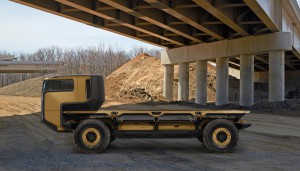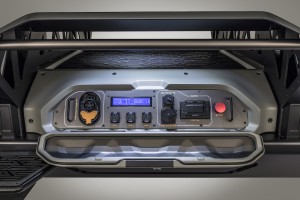
SURUS was designed to form a foundation for a family of commercial vehicle solutions that leverages a single propulsion system integrated into a common chassis.
General Motors may expand its fuel-cell research and development program with the U.S. Army, including the company’s new Silent Utility Rover Universal Superstructure platform, also known as SURUS.
The Army has been testing the fuel cell-powered Chevrolet Colorado ZH2 on U.S. bases for the past six months to determine the viability of hydrogen-powered vehicles in military-mission tactical environments.
Now the two sides are in talks to add the SURUS to that evaluation program. The SURUS is flexible fuel cell-powered, four-wheel concept with autonomous capabilities. It is based on a heavy-duty truck frame and designed as a “foundation” for a new generation of commercial vehicles that leverages a single propulsion system integrated into a common chassis, according to GM officials.
“SURUS redefines fuel cell electric technology for both highway and off-road environments,” said Charlie Freese, executive director of GM Global Fuel Cell Business. “General Motors is committed to bringing new high-performance, zero-emission systems to solve complex challenges for a variety of customers.”
(GM, U.S. Army unveil Colorado fuel-cell pickup. Click Here for the story.)
The automaker said Friday that the discussions with the Army Tank Automotive Research, Development and Engineering Center about the SURUS could be “a next step of the broader collaboration to evaluate fuel cell technology for future military applications.”

The Exportable Power Takeoff (EPTO) feature demonstrates how high-voltage DC from the fuel cell stack could be converted to both high- and low-voltage AC to power tools or equipment.
The platform will be on display at the fall meeting of the Association of the U.S. Army next week in Washington, D.C. It can be configured for a wide-array of applications.
Outside military solutions, GM is evaluating SURUS for a wide-range of applications such as freight; mobile and emergency backup power generation; light- and medium-duty trucks; and emergency rescue vehicles such as ambulances and others used in disaster-relief efforts, helping reduce human exposure to harm.
(For more on the Navy fuel-cell project, Click Here.)
GM says SURUS has a range of more than 400 miles and is about 16.5 feet long and 7.5 feet wide.
In the meantime, the Army has been testing the Colorado in off-road conditions, evaluating power generation, reduced odor, acoustic and thermal signatures, high wheel torque, extended operating range and potential use of the byproduct water: all vital controllables for future military vehicles.
Military testing has shown the ZH2 reduced acoustic nondetection distance by 90% compared with current military vehicles in operation, according to GM. This means the ZH2 can get 10 times closer before being detected, the company notes.
(To see more about GM partnering with Honda on fuel-cell development, Click Here.)
Last year, the U.S. Navy unveiled a GM fuel cell-powered Unmanned Undersea Vehicle (UUV) for testing purposes that leverages GM fuel cell technology common with the Colorado ZH2.
